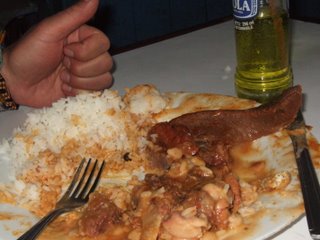
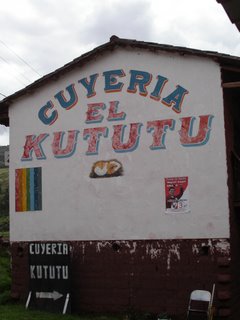


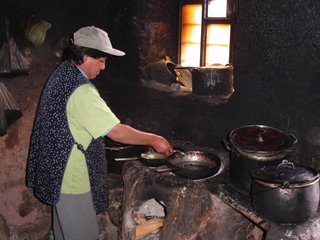


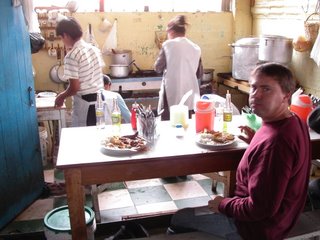
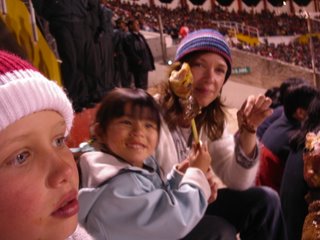
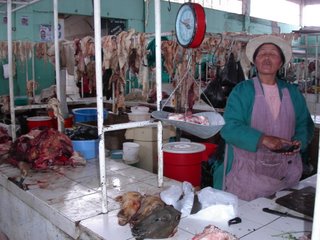


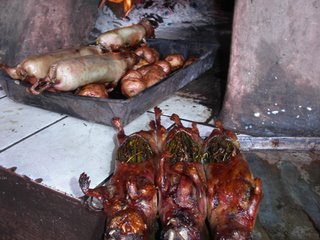

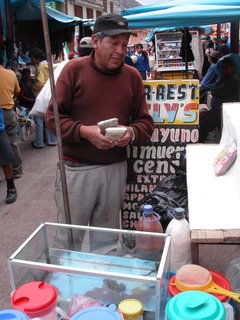
One of the great things about Cusco is the food. Not only is Peruvian food great in itself, but, if you think about it, it´s kind of great to go to a place where they have a type of food. When´s the last time you went out for American or Canadian? While there are, of course, different types of food, also of considerable interest to the tourist are the different types of places in which to enjoy said food. The first stop for many are the traditional Peruvian restaurants, generally on or near the Plaza de Armas, which serve set prices menus of a soup, a main course, and a drink or dessert for around $3-7. Also catering to tourists are the funkier, hip restaurants scattered around the historic center of the city. The food, décor, and ambience in these restaurants are on par with any I’ve found in San Diego or LA and the entrées generally run around $10. However, if you want real Peruvian food you need to go to where the locals eat and that means getting away from the tourist traps and finding some Picanterias, Cevicherias, Cuyerias, and Chicharronerias. You may also stumble across the occasional Pollo Broaster or Pizzaria, which can be quite good but, it seems to me that it kind of defeats the purpose of going to a foreign country if you are going to eat the same food you can get back home (one of the nicest things about Cusco is that there are NO U.S. fast food restaurants in Cusco). The locals’ restaurants are both considerably cheaper, with multi-course menus running from about $.60-$2, and generally much more interesting; local color is free and there’s often an interesting dynamic that develops when you’re the only Gringo in the place. Then, for the adventuresome eater, there are the food stalls on the street and in the local markets. Above, you can see a picture of Bart dining at a stall in the San Pedro market and in the first picture, my plate of beef tongue and beans. There was no restaurant open in the evenings within walking distance of our house so a couple of times the kids and I have enjoyed a greasy but tasty noodle, French fry, chicken combination from a local street vendor. For $.30-.$60 you get a filling meal and, for no extra charge, an audience of usually one or more dogs and an ubiquitous black cat who is often more intrusive than the canines, as you can see in the picture of Zak above. Unexpectedly, one of the best places I’ve found for local food is the local soccer stadium. Instead of munching on hot dogs and peanuts during the game, you can choose from a plate of noodles with a fried egg on top or some delicious anticuchus (grilled beef hearts) on a skewer with a potato, which you can see Maya enjoying in the picture above with her mother and brother.
Then there´s the food itself. Of first interest to us furry mammal loving Norte Americanos is the Cuy or roasted guinea pig. I have to admit that I like them both as pets and meat although, even cooked, the skin can be a bit chewy and one has to put in a pretty workout with the incisors to get a decent amount of meet off of the little rodents. Alpaca is also very cute one the hoof, tasty on the plate, and surprisingly lean; look for the places that serve it in thin slices. Ceviche also originated in Peru. For the uninitiated, ceviche is raw fish marinated in limes and onions. It tastes as good as it sounds! Actually, the acids from the citrus essentially cook the fish leaving you with a cool, flavorful repast that accentuates the subtle flavors of the fish without that “fishy” smell so many people seem to dislike. Ceviche is generally served with sweet potatoes, roasted corn kernels, rice, and is accompanied by a soup made from the citrus/fish juices, muy rico (very good)! At the cevicheria you may also want to try a shot of the Leche de Tigre which supposedly gives a little boost to your virility, although I suspect that is more from the act of actually drinking the raw fish juice concoction than any inherent medicinal properties in the drink itself. In an earlier post I mentioned chicharrónes and hey, pig fried in pig fat and served with salt and corn has got to be good… and it is. Most chicharrón restaurants also serve caldo, a soup with a base of pork in a fermented broth. Fermentation certainly has it’s time and place – it’s downright indispensable to happy hour – and while that time might extend to the soup course, it requires a bit of an acquired taste to extend that place to the soup bowl. The corn served with chicharrónes is worthy of mention itself. The kernels are huge and sweet and light yellow. You can also find boiled ears for sale on the streets or in markets served with the local salty, white, soft cheese. Keep your eyes open for street vendors serving roasted corn kernels with salt (as well as Abas, a type of big legume); bonus if they’re still warm. They´re excellent with a glass of the local Cusquena lager (but then most things are)! Potatoes also originated in peru and, apparently, hundreds of varieties are available. Local food tends heavily toward the carbohydrates. For one thing, carbs are cheap and filling and also are apparently advantageous for metabolizing oxygen at high altitudes. However, a steady diet of such food isn’t too kind to the waistline; as is evident in every woman of childbearing age I saw. My local friends were incredulous that my wife Mary was on the positive side of 25, the mother of two children, and still looked great.
While we in North America have gotten used to having fresh bananas and oranges and apples at any time of the year, it never really crossed my mind before I left that I would have an entirely different crop of fruit to choose from down here in South America. In the picture above you can see two of my favorites. On the left is a Granadilla. Once one breaks through the crunchy shell, one is rewarded with a bunch of small seeds attached to each other by a king of sweet viscous material. When you slurp down a glob you get the interesting sensation of eating some that is sweet and smooth and crunchy all at the same time. This was also one of Zak´s favorites although, interesting, both his mother and grandparents couldn’t get past the texture which is not unlike the sensation of slurping down a big “loogie” albeit one that is quite tasty. On the right is a cherimoya. The flesh is sweet and fairly solid and surrounds big black seeds which you have to spit out as you eat. The final picture is of a food that even I didn’t try. Mary and I saw a tank of frogs at a local (non-tourist) market in Urubamba. I asked if they were for pets and the man replied that no, they were meant to be blended with some sugar and dark non-alcoholic beer and consumed. He assured me that they were of great benefit for the treatment of the common cold. This information was confirmed by my friend Jaime the taxi driver who went on to tell me about a variety of home remedies used in the campo by the campesinos who have neither access to nor money for the fancy medicines in a pharmacy. My theory is that any kid with a cold who is threatened with said remedy is sure to say he feels better right away, even if he really doesn’t.
Then there’s the drinks. Zak and I were quite fond of Inka Cola. I enjoy it’s light cream soda flavor but Mary Walsh almost ruined it for me completely when she noted that it tasted, to her, like liquid bubble gum. The name, Inka Cola is not without its own significance. To me, the two words represent the essence of both the ancient and the modern and the conjunction of these two words in the name of a popular soda is indicative of the struggle faced by this country as it tries to straddle the divide between these two realms. Many places will also serve chicha morada, a semi-sweet natural drink that apparently a healthier than sodas. At outdoor markets one can also find chicha quinoa, which is refreshing and contains negligible amounts of alcohol and, on the stronger side, there is chicha, the thick homemade corn beer which is served at room temperature. For the more traditional malted alcoholic beverage there is Cusquena, a local beer which comes in a lager and a dark, sweet malt. Interestingly, Cusquena is the largest manufacturing entity in town and is the only major economic enterprise other than tourism. The local strong alcohol drink is called a pisco sour which is evocative of a margarita. Like a margarita, which combines tequila and triple sec, pisco sours combine a harsh tasting pisco, which is actually a fortified wine, with a sweet, syrupy jarabe. The two are then blended with egg whites and little angostura bitters for a foamy delectable delight. A word of warning: as Bart and Susie and I discovered, much to our delight, one night after happy hour at the Cross Keys on the Plaza de Armas, it is very difficult to distinguish a strong pisco sour from a weak pisco sour. My theory is that traveling is also something done with the stomach so put down that hamburger and get out there!

















0 Comments:
Post a Comment
<< Home